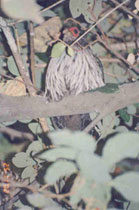 |
'My name is
Yasser Arafat. Watching wild life is my hobby from the beginning. Recently I completed MBA but not interested in that type of work. I wanted to do something for the conservation of endangered wild animals and birds of Himalaya. I have started wild life
photography and videography from last one year and have plenty of genuine knowledge of Pheasants and wild animals of Himalaya.'
|
Khalij Pheasant – Lophura Leucomelanos
By Yasser Arafat
I think most common of all pheasants is the khalij pheasant. 65cm long, this bird is a resident of the Himalayas, North East India, Bangladesh and Nepal. Facial skin of both sexes is red. Female is dull brown to reddish brown
in colour, whereas, the male is shining black above with steel blue gloss, ending in a glossy curved tale with variable amount of white on rump and under parts.
Great ability to survive in various types of conditions. In Himalayas upto 3,500 mteres khalij can be seen every where, where there is a stream flowing with thick under growth. In winters they can be seen in flocks, birds upto
15-16 in numbers.
Pairing starts from end of March. I have seen female with chicks on 17th April and same year I have seen female hatching eggs on 12th May. On nest I have found not more than eight eggs. Female makes nests in thick undergrowth,
under a big rock or in the burrow made by roots of big trees.
In the month of April and May females hatch their eggs while male roost in the tree near by. After the chicks come out of eggs female moves to another place and never remains in the same place. I have also seen eight males roosting on a tree on 3rd June without
any female and chicks.
 From mid July chicks also started roosting on tree and small bushes.
From mid July chicks also started roosting on tree and small bushes.
During breeding season males courting display is worth seeing . But fighting between two khalij males is also a wonderful sight to watch. I have documented these fights on video.
Food consists of seeds, insects, fruit, and human excreta around habitation.
Calls- chuckling calls mostly on being disturbed; otherwise much vocal communication occurs only during breeding season.